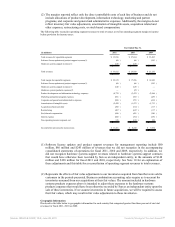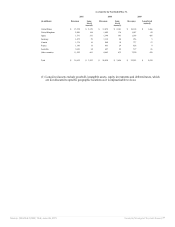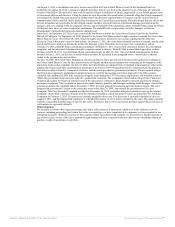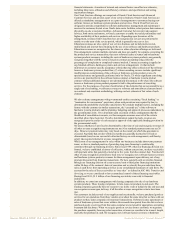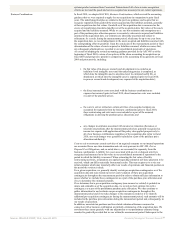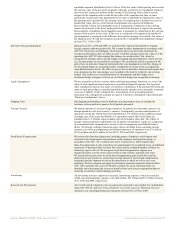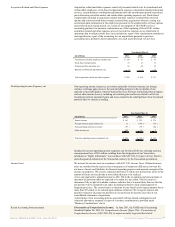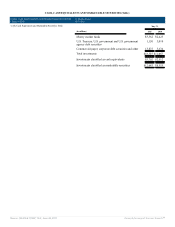Oracle 2010 Annual Report Download - page 213
Download and view the complete annual report
Please find page 213 of the 2010 Oracle annual report below. You can navigate through the pages in the report by either clicking on the pages listed below, or by using the keyword search tool below to find specific information within the annual report.
systems product revenues from Concurrent Transactions if all of our revenue recognition
criteria are met and the goods and services acquired are necessary for our current operations.
Business Combinations In fiscal 2010, we adopted ASC 805, Business Combinations, which revised the accounting
guidance that we were required to apply for our acquisitions in comparison to prior fiscal
years. The underlying principles are similar to the previous guidance and require that we
recognize separately from goodwill the assets acquired and the liabilities assumed, generally
at their acquisition date fair values. Goodwill as of the acquisition date is measured as the
excess of consideration transferred and the net of the acquisition date fair values of the assets
acquired and the liabilities assumed. While we use our best estimates and assumptions as a
part of the purchase price allocation process to accurately value assets acquired and liabilities
assumed at the acquisition date, our estimates are inherently uncertain and subject to
refinement. As a result, during the measurement period, which may be up to one year from
the acquisition date, we record adjustments to the assets acquired and liabilities assumed with
the corresponding offset to goodwill. Upon the conclusion of the measurement period or final
determination of the values of assets acquired or liabilities assumed, whichever comes first,
any subsequent adjustments are recorded to our consolidated statements of operations.
As a result of adopting the revised accounting guidance provided for by ASC 805 as of the
beginning of fiscal 2010, certain of our policies differ when accounting for acquisitions in
fiscal 2010 and prospective periods in comparison to the accounting for acquisitions in fiscal
2009 and prior periods, including:
• the fair value of in-process research and development is recorded as an
indefinite-lived intangible asset until the underlying project is completed, at
which time the intangible asset is amortized over its estimated useful life, or
abandoned, at which time the intangible asset is expensed (prior to fiscal 2010,
in-process research and development was expensed at the acquisition date);
• the direct transaction costs associated with the business combination are
expensed as incurred (prior to fiscal 2010, direct transaction costs were included
as a part of the purchase price);
• the costs to exit or restructure certain activities of an acquired company are
accounted for separately from the business combination (prior to fiscal 2010,
these restructuring and exist costs were included as a part of the assumed
obligations in deriving the purchase price allocation); and
• any changes in estimates associated with income tax valuation allowances or
uncertain tax positions after the measurement period are generally recognized as
income tax expense with application of this policy also applied prospectively to
all of our business combinations regardless of the acquisition date (prior to fiscal
2010, any such changes were generally included as a part of the purchase price
allocation indefinitely).
Costs to exit or restructure certain activities of an acquired company or our internal operations
are accounted for as one-time termination and exit costs pursuant to ASC 420, Exit or
Disposal Cost Obligations, and, as noted above, are accounted for separately from the
business combination. A liability for a cost associated with an exit or disposal activity is
recognized and measured at its fair value in our consolidated statement of operations in the
period in which the liability is incurred. When estimating the fair value of facility
restructuring activities, assumptions are applied regarding estimated sub-lease payments to be
received, which can differ materially from actual results. This may require us to revise our
initial estimates which may materially affect our results of operations and financial position in
the period the revision is made.
For a given acquisition, we generally identify certain pre-acquisition contingencies as of the
acquisition date and may extend our review and evaluation of these pre-acquisition
contingencies throughout the measurement period in order to obtain sufficient information to
assess whether we include these contingencies as a part of the purchase price allocation and,
if so, to determine the estimated amounts.
If we determine that a pre-acquisition contingency (non-income tax related) is probable in
nature and estimable as of the acquisition date, we record our best estimate for such a
contingency as a part of the preliminary purchase price allocation. We often continue to
gather information for and evaluate our pre-acquisition contingencies throughout the
measurement period and if we make changes to the amounts recorded or if we identify
additional pre-acquisition contingencies during the measurement period, such amounts will be
included in the purchase price allocation during the measurement period and, subsequently, in
our results of operations.
In addition, uncertain tax positions and tax related valuation allowances assumed in
connection with a business combination are initially estimated as of the acquisition date. We
reevaluate these items quarterly with any adjustments to our preliminary estimates being
recorded to goodwill provided that we are within the measurement period. Subsequent to the
Source: ORACLE CORP, 10-K, June 28, 2011 Powered by Morningstar® Document Research℠


